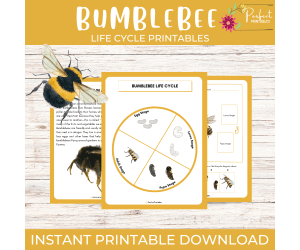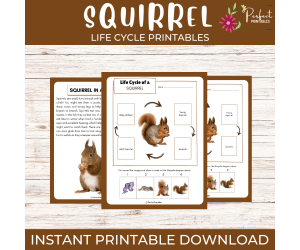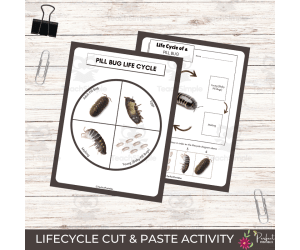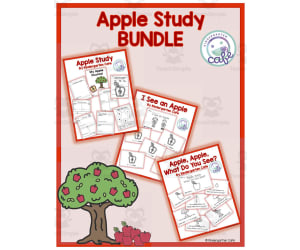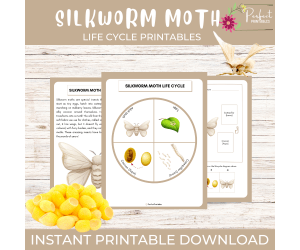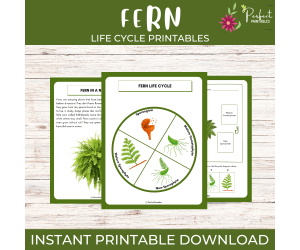2,755 products added recently
Science: Parts of and Anatomy of
Anatomy of a Caribou
Science, Life Sciences, Animals, Grade 3, 4, 5, Parts of and Anatomy of, Worksheets & Printables
The Anatomy of a Caribou Teaching Resource Our set of expertly hand-illustrated, watercolor flashcards are designed explicitly for Grades 3 to 5 Science educators. Through the fascinating world of Zoology, these detail-oriented tools impeccably depict the intricate anatomy of the captivating caribou species. The cards come as digital downloads in PNG format sized to A4, providing an enriching visual aid during lectures or study sessions. The lush use of colors taps into younger students' visual learning abilities, making each session more engaging with bursts of vibrant colors that bring life to scientific concepts. Dual Functionality and High-quality File Type Crisp visuals: Our high-quality file type ensures that even when printed on regular paper, the diagrams retain their clarity. Tactile experience: For an interactive experience enhancing artistic skills alongside science instruction, teachers may opt to print on watercolor paper—letting students participate through painting and adding personal touches. Versatile Learning Tool An ideal tool for not only whole-class instruction but also effective supplementary material during small group discussions or independent study sequences. This gives students time and freedom for self-paced analysis without overwhelming them with too much information simultaneously. Simple instructions in each card's design layout enrich it with educational content—becoming a surefire hit in classrooms! Additionally offering maximum flexibility during utilization makes it perfect not only within traditional classroom settings but also beneficial homeschool environments catering elementary-level learners interested in exploring science topics intensely. In Conclusion, >/p Foster appreciation for art and nature's beauty by utilizing our Anatomy of a Caribou pack. It's a wonderful way to seamlessly infuse student enthusiasm for learning core sciences and creative skill-building to achieve excellent academic performance as well as immerse students in the wonders of nature.
Author Fiddleticks Education
Tags Caribou Anatomy, Zoology, Flashcards, Watercolor Illustrations, Science Education
Anatomy of an American Bison
Science, Life Sciences, Animals, Grade 1, 2, 3, 4, 5, Parts of and Anatomy of, Worksheets & Printables
This pack includes my own beautiful hand-painted watercolor bison depicted on a picturesque background. The pack also includes a set of body parts and labels that can be cut out and placed around the animal, creating your own anatomy poster. All parts and labels show the parts of the bison and their traditional historical uses.
Author Fiddleticks Education
Tags Bison, Anatomy, Animals, Watercolor, Poster
Anatomy of a Leopard Seal
Science, Life Sciences, Animals, Grade 1, 2, 3, 4, 5, Parts of and Anatomy of, Worksheets & Printables
Anatomy of a Leopard Seal depicts a playful leopard seal with colorful anatomical labels . This hand-illustrated watercolor print engages students while teaching facts about the leopard seal's bodily systems and features. Educators can facilitate whole-group instruction by projecting the image and asking students to identify parts of the seal. Alternatively, they may print copies for small groups to label independently and present their findings. Students will enjoy learning more about the fauna of Antarctica through this vibrant display print. Whether admiring the artistry or analyzing the content, Anatomy of a Leopard Seal offers an entertaining way to explore science.
Author Fiddleticks Education
Tags Poster, Leopard, Seal, Anatomy, Watercolor, Seals Anatomy
Anatomy of a Bald Eagle
Science, Life Sciences, Animals, Grade 3, 4, 5, Parts of and Anatomy of, Worksheets & Printables
Anatomy of a Bald Eagle hand-illustrated watercolor flashcards . To create a tactile finished item, I highly recommend printing onto high-quality paper. I like to use watercolor paper as this also allows the children to add their own paintings to the pages they create and means that every piece looks and feels like an original painting.
Author Fiddleticks Education
Tags Eagle, Anatomy, Watercolor, Animals, Bald Eagle Anatomy Diagram, Bald Eagles Anatomy
Anatomy of a Dandelion
Science, Earth and Environmental Sciences, Earth Sciences, Grade 3, 4, 5, Parts of and Anatomy of, Worksheets & Printables
A beautiful hand-illustrated watercolor print is showing a poppy and all the printables /parts-of-and-anatomy-of">parts of its anatomy. It can be used to brighten up a room or as an educational print. To create a lasting and tactile item, I highly recommend printing the file onto watercolor paper. It creates a beautiful finish and looks like you are handling original paintings.
Author Fiddleticks Education
Tags Poster, Dandelion
Anatomy of a Badger
Science, Life Sciences, Animals, Grade 3, 4, 5, Parts of and Anatomy of, Worksheets & Printables
Anatomy of a Badger: An Interactive Teaching Resource Anatomy of a Badger is designed to augment the learning experience for 3rd, 4th, and 5th grade students in science class, with a particular focus on zoology. It acts as an engaging and interactive tool for introducing wildlife biology through visual stimuli. Product Contents: Hand-illustrated watercolor flashcards depicting badger anatomy Digital downloadable file in PNG format sized for A4 paper The resource's highlight are sparkling watercolor flashcards that capture the anatomical details of badgers authentically. Presenting these vibrant images can grasp young learners' interest as they explore the fascinating world of animal structures. To enhance its effectiveness, we recommend printing this educational material on high-quality paper for durability and improved sensory appeal. To add an interactive learning component, one might choose watercolor paper that allows learners to apply their own paintwork over existing illustrations. Note: Upon purchase, educators get access to a ready-to-print digital copy. Versatility at its Core: Anatomy of a Badger can be utilized during whole group sessions or small group activities; it potentially functions as homework assignments too. Encouraging children towards independent exploration furthers their understanding about animal anatomy organically. Fostering Dynamic Learning Experiences! Incorporating Anatomy of a Badger into your instructional routine creates exciting and immersive science classes – promoting interest-driven learning grounded by facts with guided discovery. The advantages yielded using visual aids can noticeably bolster information retention while stimulating curiosity about diverse creatures populating our natural world. To sum up, Anatomy of a Badger provides a simple yet enriching aid in teaching zoology, molding potential young biologists to have adequate foundational knowledge about various animals' anatomic complexities - notably starting with badgers!
Author Fiddleticks Education
Tags Badger Anatomy, Wildlife Biology, Zoology Education, Visual Aids, Animal Structures
The Plants We Eat: A Parts of a Plant Anchor Charts and Posters
Science, Life Sciences, Nature & Plants, Biology, Kindergarten, Preschool, Grade 1, Parts of and Anatomy of, Worksheets & Printables
Did you know we can eat all parts of plants. This parts of a plant anchor chart posters includes real images of fruits and vegetables for students to familiarize themselves with all the parts of a plant they can eat! This poster set includes flowers, seeds, leaves, stems, roots, and fruits. There are 6 images for each plant part. Pictures Included: Flowers: artichoke, broccoli, cauliflower, dandelion, honeysuckle, squash blossom Fruits: apple, banana, blueberry, lime, pepper, raspberry Leaves: kale, lettuce, mint, parsley, purple cabbage, spinach Roots: carrot, garlic, onion, parsnip, radish, sweet potato Seeds: almonds, beans, coconut, corn, peas, sesame seeds Stems: asparagus, bamboo shoots, celery, leek, rhubarb, scallions How to Use: These charts can be used as wall decor in a science center or as an instructional tool to teach about the plants we eat. By relating the science standard of identifying parts of a plant to foods that students commonly eat, it will ensure that students have fun and stay engaged with learning about plants! Where to Use: Wall Display in a Science Center - Place these posters on the wall of a science center while you are learning about the parts of plants. They can also be placed in a science center simply as a reference tool for students to use while completing other plant based activities. Instructional Tool - These posters make an excellent instructional tool for teachers to use to introduce to students the concept of parts of a plant in relation to the foods we eat. The real photographs in this set provide students with easy to recognize images of different edible plants. Students will love seeing all the pictures of the different kinds of plants that they can actually eat. These anchor charts and posts are no prep. The posters just need to be printed out and laminated for durability if desired.
Author The Connett Connection
Tags Plants We Eat, Parts Of A Plant
Anatomy of a Wildfire Poster | Printable Science / Geography Educational Poster
Science, Earth and Environmental Sciences, Earth Sciences, Not Grade Specific, Parts of and Anatomy of, Worksheets & Printables
A beautiful hand-illustrated watercolor print featuring a wildfire with the different parts labeled labels. An ideal accompaniment to science, nature , or geography study. To create a lasting and tactile item I highly recommend printing the file onto watercolor paper, it creates a beautiful finish and really looks like you are handling original paintings.
Author Fiddleticks Education
Tags Anatomy, Geography, Science, Wildfire Posters
Life Cycle of a Woolly Bear Caterpillar Worksheet - Insect Science
Montessori, Insects, Life Sciences, Science, Biology, STEM, Kindergarten, Preschool, Grade 1, 2, 3, Posters, Classroom Decor, Flashcards, Worksheets & Printables, Parts of and Anatomy of
Let's introduce your students to the amazing transformation of the Woolly Bear Caterpillar with this fun and educational worksheet pack! Perfect for young learners, this resource helps kids explore each stage of the woolly bear’s life cycle in a simple, hands-on way. From fuzzy little caterpillar to beautiful Isabella tiger moth, this science unit makes learning about insects exciting and easy to understand. What’s Inside In This File? : Woolly Bear Overview: A short and engaging description of what makes woolly bear caterpillars special, where they live, and what they turn into. Life Cycle Diagram: A clearly labeled chart showing the stages from egg to caterpillar to chrysalis to moth. Cut-and-Paste Activity: A fun sequencing activity where kids can cut and arrange the stages of the life cycle. Flashcards: Visual learning tools to help students remember each stage. Bonus Coloring Page: A creative way to reinforce learning while coloring a woolly bear caterpillar or moth. This Worksheet is Perfect For: Insect and animal science units Fall or seasonal studies Classroom centers and homeschool lessons Nature-themed activities What your students will learn from this file? Identify the stages of a woolly bear caterpillar’s life Understand insect metamorphosis Strengthen sequencing and observation skills This worksheet is a fun mix of science and creativity that brings the life of the woolly bear caterpillar to life for curious young learners!
Author Perfect_Printables
Rating
Tags Woolly Bear Caterpillar , Life Cycle, Caterpillar Worksheet, Insect Science Unit, Life Cycle Printables, Homeschool Science, Biology For Kids, Montessori Insect Unit, Caterpillar To Moth, Insect Study
Life Cycle of a Bumblebee Worksheet - Insect Science Unit Study
Montessori, Animals, Life Sciences, Science, Insects, STEM, Kindergarten, Preschool, Grade 1, 2, 3, Bulletin Boards, Classroom Decor, Posters, Flashcards, Worksheets & Printables, Parts of and Anatomy of, Coloring Pages, Worksheets
Have you ever wondered how a tiny bumblebee grows from an egg into a buzzing pollinator? This Life Cycle of a Bumblebee Worksheet is a fun and interactive way to learn about the different stages of a bumblebee’s life. Perfect for science lessons, homeschool studies, and insect-themed activities, this worksheet helps students explore the world of bees in an engaging way! What you will get in this Printable File? Bumblebee Overview – Learn what makes bumblebees special, where they live, and why they are important pollinators. Life Cycle Diagram – A clear and labeled chart showing each stage, from egg to adult bee. Cut-and-Paste Activity – A hands-on way for kids to sequence the life stages of a bumblebee. Flashcards – Visual tools to help students remember each stage of the bumblebee’s growth. Bonus Coloring Page – A creative activity to color a bumblebee while learning about its life cycle! This worksheet is perfect for: Helps students understand insect life cycles in a simple and visual way. Encourages hands-on learning with fun, interactive activities. Great for classroom science lessons, homeschooling, or springtime studies. Builds sequencing, problem-solving, and observational skills. You will Learn The different stages of a bumblebee’s life, from egg → larva → pupa → adult bee . How bumblebees help pollinate flowers and support ecosystems. Fun facts about bumblebees, including how they communicate and build their nests. Let’s explore the amazing life cycle of a bumblebee together and make insect science fun!
Author Perfect_Printables
Tags Bumblebee Life Cycle, Bumblebee Worksheet, Insect Science, Life Cycle Printables, Homeschool Science, Biology For Kids, Bumblebee Activities, STEM Insect Study, Pollinators For Kids, Bee Unit Study
Life Cycle of a Squirrel Worksheet- Animal Science Unit Study
Montessori, Animals, Life Sciences, Science, Biology, STEM, Kindergarten, Preschool, Grade 1, 2, 3, Posters, Classroom Decor, Parts of and Anatomy of, Worksheets & Printables, Flashcards
Let's learn and discover the fascinating life of one of the most energetic animals in nature—the squirrel! This is a fun and interactive resource designed to help young learners understand how squirrels grow, change, and thrive in the wild. Through engaging visuals and hands-on activities, students will explore each stage of the squirrel’s life in a way that’s easy to understand and fun to follow. What’s Included In This File: Squirrel Overview: A simple and kid-friendly introduction to squirrels, their habitats, and their role in the ecosystem. Life Cycle Diagram: A clearly labeled chart showing the journey from baby squirrel (kit) to adult. Cut-and-Paste Activity: A fun sequencing task to help kids organize and remember each life stage. Flashcards: Visual aids to reinforce vocabulary and science learning. Bonus Coloring Page: A cute squirrel to color while reviewing what they’ve learned. This Project is Perfect For Animal science or forest animal units Fall-themed lessons or outdoor nature studies Homeschool, classroom centers, or early finishers Students who love animals and wildlife What You Will Learn from this worksheet? Learn the four main stages of a squirrel’s life Understand how squirrels grow and survive in their environment Practice sequencing, observation, and science vocabulary This worksheet pack combines creativity and science to make learning about squirrels exciting and memorable for kids!
Author Perfect_Printables
Rating
Tags Squirrel Life Cycle, Squirrel Worksheet, Animal Science Unit, Homeschool Science, Biology For Kids, Squirrel Activities, STEM Animal Study, Nature Study For Kids, Preschool Science, Squirrel Growth Stages
Life Cycle of a Cheetah Worksheet- Animal Science Unit Study
Montessori, Animals, Life Sciences, Science, Biology, STEM, Kindergarten, Preschool, Grade 1, 2, 3, Posters, Classroom Decor, Flashcards, Worksheets & Printables, Parts of and Anatomy of
Let you kids learn about the biggest wild cat with our " Life Cycle of a Cheetah Worksheet ! This engaging and kid-friendly science resource is designed to help students explore how cheetahs grow, change, and survive in the wild. With fun facts and interactive activities, learners will discover the unique life stages of the fastest land animal on Earth! What’s Included In this file? Cheetah Overview: A short and exciting introduction to cheetahs, where they live, what they eat, and what makes them special. Life Cycle Diagram: A clear, easy-to-follow chart showing each stage of a cheetah’s life—from cub to adult. Cut-and-Paste Activity: A hands-on activity that lets students cut out and sequence the stages of the cheetah’s life. Flashcards: Visual cards to help reinforce science vocabulary and life cycle steps. Bonus Coloring Page: A fun and relaxing way to review with a cheetah-themed coloring activity. This Worksheet is perfect for Animal science and wild animal units African wildlife studies Classroom centers or homeschool lessons Students who love big cats and nature What you will learn from this worksheet? Understand the stages in a cheetah’s life cycle Learn how cheetahs grow and survive in their environment Build sequencing and critical thinking skills through interactive tasks This worksheet pack is a great mix of science, fun, and creativity—perfect for helping kids connect with the wild world of cheetahs!
Author Perfect_Printables
Rating
Tags Cheetah Life Cycle, Cheetah Worksheet, Animal Science Unit, Homeschool Science, Biology For Kids, Cheetah Activities, Nature Study For Kids, Montessori Wildlife Unit, Savanna Animals, Cheetah Growth Stages
Life Cycle of a Venus Flytrap Worksheet- Plant Science Unit Study
Montessori, Life Sciences, Science, Biology, Nature & Plants, Kindergarten, Preschool, Grade 1, 2, 3, Posters, Classroom Decor, Flashcards, Worksheets & Printables, Parts of and Anatomy of
Let’s explore one of the most exciting plants in nature – the Venus Flytrap! This simple and fun worksheet helps students learn all about how this amazing carnivorous plant grows and survives. It’s a great way to spark curiosity and get kids excited about plant science. What’s Included in this Worksheet? A Short Overview : A short and easy-to-understand description of what makes the Venus Flytrap special and where it grows. Life Cycle Diagram: A clear chart showing each stage of the plant’s life, from seed to fully grown trap. Cut-and-Paste Activity: A fun hands-on way for students to put the life cycle stages in the correct order. Flashcards: You will get a flashcards set of All stages of life Bonus Coloring Page: A venus flytrap coloring page also included! This is Perfect For: Science lessons about plants and unique species Classroom centers or independent activities Homeschool plant studies Spring or nature-themed units What you will learn from this project? Understand each stage in the Venus Flytrap’s life cycle Learn how it catches insects and survives in its habitat Build sequencing and observation skills through interactive activities This resource is a fun mix of science and creativity—designed to make learning about the Venus Flytrap simple, exciting, and memorable for young learners.
Author Perfect_Printables
Rating
Tags Venus Flytrap , Life Cycle, Carnivorous Plant , Plant Science Unit, Life Cycle Printables, Homeschool Botany, Venus Flytrap Activities, STEM Plant Study, Nature Study For Kids, Montessori Botany Unit
Animal Cell Diagram
Science, Life Sciences, Animals, Biology, High School, Elementary, Middle School, Worksheets & Printables, Worksheets, Diagrams, Teacher Tools, Parts of and Anatomy of
A printable animal cell diagram for learning the parts of the animal cell. Perfect for elementary, middle and high school biology lessons. The parts labeled in the document include: cytoplasm, ribosomes, nucleus, nucleolus, Golgi apparatus, rough endoplasmic reticulum, smooth endoplasmic reticulum, cytoskeleton, centrioles, chromatin, mitochondria, and lysosomes. This PDF includes both the color and black and white versions of the diagram. The first two pages contain the labeled diagram. The third and fourth pages contain the blank diagram with lines for labeling. The fifth and sixth pages contain only the illustrations of the animal cell diagram to use as decoration etc. Animal Cell Diagram created by Tim van de Vall. It is copyright Tim’s Printables LLC. Terms of use: Content may be printed/downloaded for personal and educational purposes only. Commercial Use is strictly prohibited. Thank you for respecting these terms! 6 pages total. The page dimensions are: letter-sized 8.5”x11”. PDF format.
Author Tim's Printables
Rating
Tags Animal Cell, Biology, Science, Cell Parts, Prokaryotes, Worksheet, Printable, Cell, Nucleus, Golgi Bodies
Life Cycle of a Rose - Flowering Plant Unit Study With Fun Facts!
Montessori, Nature & Plants, Life Sciences, Science, STEM, Kindergarten, Preschool, Grade 1, 2, 3, Flashcards, Worksheets & Printables, Parts of and Anatomy of, Coloring Pages, Worksheets
Introduce your students to the beauty and science of how roses grow with this fun and engaging Life Cycle of a Rose worksheet! Perfect for early learners, this resource makes it easy to explore the stages of a rose’s life from seed to full bloom. With clear visuals, simple explanations, and interactive activities, kids will love learning about one of nature’s most beautiful flowering plants. This activity pack helps young learners build an understanding of plant biology while developing sequencing and observation skills. It’s a great addition to any plant science unit or spring-themed classroom lesson. What’s Inside In This Worksheet? A labeled rose life cycle diagram Rose in a nutshell Cut-and-paste activity to sequence the stages Fun facts about roses and how they grow Rose Life Cycle Flashcard Bonus coloring page to spark creativity This Activity Pack is Perfect For: Flowering plant science units Spring classroom themes Homeschool nature studies Hands-on science centers Let your students dig into plant science with this simple, educational, and beautiful rose life cycle worksheet!
Author Perfect_Printables
Rating
Tags Rose Life Cycle, Rose Worksheet, Flowering Plant Unit, Plant Science Printables, Homeschool Botany, Rose Activities For Kids, STEM Plant Study, Hands-on Flower Science, Montessori Botany Unit, Rose Growth Stages,
Life Cycle of a Pill Bug Worksheet- Roly Poly Unit Study With Fun Fact
Montessori, STEM, Biology, Life Sciences, Science, Insects, Kindergarten, Preschool, Grade 1, 2, 3, Posters, Classroom Decor, Flashcards, Worksheets & Printables, Coloring Pages, Worksheets, Parts of and Anatomy of
Let’s introduce your students/kids with amazing bug Pill Bug with this amazing worksheet! This fun and educational resource is perfect for young learners who are curious about bugs—especially the adorable roly poly! Students will explore the unique life of pill bugs, from tiny eggs to fully grown adults, and learn how these little creatures live and grow in their natural habitats. This worksheet pack is designed to be simple, engaging, and hands-on, making science both fun and memorable for kids. What’s Inside In this file? Pill Bug Overview: A short, kid-friendly introduction to what pill bugs are, where they live, and why they’re important in nature. Life Cycle Diagram: A clearly labeled chart showing each stage of the pill bug’s life cycle. Cut-and-Paste Activity: An interactive way for students to practice sequencing and understanding life stages. Flashcards: Visual cards that help reinforce vocabulary and stages. Bonus Coloring Page: A fun way to review and relax while coloring a cute pill bug! This worksheet is Perfect For Bug and insect-themed science lessons Spring or garden unit studies Homeschool and classroom centers Students who love exploring nature What your students/kids will learn from this file? Understand the life cycle of a pill bug Learn fun facts about roly polies Strengthen sequencing and observation skills This worksheet brings science to life with real curiosity and creativity—perfect for helping kids fall in love with the tiny wonders of nature!
Author Perfect_Printables
Rating
Tags Pill Bug Life Cycle, Roly Poly Worksheet, Isopod Science Unit, Life Cycle Printables, Homeschool Biology, Pill Bug Activities, Nature Study For Kids, Montessori Bug Unit, Bug Growth Stages, Backyard Biology
Apple Study Bundle | Journal, Reader & Parts of An Apple
Science, Life Sciences, Nature & Plants, Preschool, Grade 1, 2, Parts of and Anatomy of, Worksheets & Printables
This download is a bundle of resources for your Apple Study. Resources included are: -Apple Journal -Emergent Reader - printables /parts-of-and-anatomy-of">Parts of an apple
Author Kindergarten Cafe
Tags Apple Study, Apple Journal, Emergent, Reader, Science Journal
Anatomy of an Arctic Hare
Science, Life Sciences, Animals, Grade 3, 4, 5, Parts of and Anatomy of, Worksheets & Printables
Anatomy of an Arctic Hare hand-illustrated watercolor flashcards . To create a tactile finished item, I highly recommend printing onto high-quality paper. I like to use watercolor paper as this also allows the children to add their own paintings to the pages they create and means that every piece looks and feels like an original painting.
Author Fiddleticks Education
Tags Arctic, Anatomy, Hare, Watercolor, Rabbit, Hare Anatomy
Life Cycle of a Silkworm Moth Worksheet - Insect Science Unit Study
Montessori, Animals, Life Sciences, Science, Biology, Insects, Kindergarten, Preschool, Grade 1, 2, 3, Projects, Activities, Posters, Classroom Decor, Flashcards, Worksheets & Printables, Parts of and Anatomy of
Let’s explore the amazing transformation of the silkworm moth. This Life Cycle of a Silkworm Moth Worksheet is a fun and educational way for kids to learn about insects and how they grow. This worksheet is perfect for science lessons homeschool studies and hands on classroom activities this worksheet helps students discover the full journey of a silkworm from tiny egg to flying moth What is Inside the Silkworm Moth Life Cycle Worksheet Silkworm Overview: A simple explanation of what silkworms are where they live and how they are connected to silk. Life Cycle Diagram :A clear and labeled chart showing each stage egg larva pupa and adult moth Cut and Paste Activity: A fun hands on task to help kids arrange the life stages in the correct order Flashcards : Picture cards to help remember each step of the life cycle Bonus Coloring Page You will get a silkworm coloring page with this worksheet as bonus. Why This Worksheet is Great for Kids Easy to understand and engaging for young learners Builds science knowledge and sequencing skills Encourages observation and curiosity about insects Perfect for unit studies on insects moths or the natural world What Will You Learn: The four main stages of the silkworm moth life cycle How silkworms change at each stage of growth Why silkworms are important in nature and how they help people This resource makes learning about insects fun simple and meaningful Let us discover the life of the silkworm moth together through interactive activities and fun facts
Author Perfect_Printables
Rating
Tags Silkworm Moth, Bugs Insects, Silkworm Life Cycle, Silkworm Moth Worksheet, Insect Science Unit, Life Cycle, Silkworm Activities, Insect Study, Nature Study, Metamorphosis
Anatomy of a Mute Swan Flashcards
Science, Life Sciences, Animals, Preschool, Grade 1, 2, Parts of and Anatomy of, Worksheets & Printables
A beautiful hand-illustrated watercolor print featuring the Anatomy of a Mute Swan. Great for learning more about this fascinating creature, using in nature study, or just as a beautiful display print.
Author Fiddleticks Education
Tags Anatomy , Swan , Flashcards, Science
Life Cycle of a Fern Worksheet - Plant Science Unit Study
Montessori, Life Sciences, Science, Biology, Nature & Plants, STEM, Kindergarten, Preschool, Grade 1, 2, 3, Classroom Decor, Bulletin Boards, Posters, Flashcards, Worksheets & Printables, Parts of and Anatomy of, Coloring Pages, Worksheets
Have you ever noticed ferns growing in shady forests or gardens? Unlike most plants, ferns don’t grow from seeds! In this exciting science unit, we will explore the unique life cycle of a fern and learn fun facts about these ancient plants. Get ready to discover, cut, paste, and color! What’s Inside Your Fern Life Cycle Worksheet? Fern Fun Facts – Learn where ferns grow, how they reproduce, and why they have been around for millions of years! Life Cycle Diagram – A simple and clear chart showing each stage of a fern’s life, from spore to full-grown plant. Cut-and-Paste Activity – Arrange the life cycle in the correct order by cutting and pasting the stages. Flashcards – Use these picture cards to help remember each step in a fern’s growth. Bonus Coloring Page – Get creative and color a beautiful fern! Why This Worksheet is Perfect for You! Makes learning about plants fun and interactive. Helps develop sequencing and problem-solving skills. Teaches the importance of ferns in nature and their role in ecosystems. Includes hands-on activities to reinforce learning. What Will You Learn? The unique life cycle of a fern, including spores, gametophytes, and adult ferns. How ferns reproduce without flowers or seeds. Why ferns are important for the environment. How to use sequencing and observation skills in a fun way! Let’s grow our knowledge and explore the fascinating life cycle of a fern together!
Author Perfect_Printables
Tags Fern Life Cycle, Plant Science Worksheet, Botany Activities For Kids, Life Cycle Printables, Biology For Kids, STEM Plant Study, Educational Worksheets, Kindergarten Learning, Montessori Botany, Plant Reproduction
Anatomy of a Barn Owl
Science, Life Sciences, Animals, Grade 1, 2, 3, 4, 5, Parts of and Anatomy of, Worksheets & Printables
Anatomy of a Barn Owl hand-illustrated watercolor poster .
Author Fiddleticks Education
Tags Anatomy, Owl, Animals, Watercolour
Plants - Anatomy of the Flowering Plant - Middle School Science
Science, Life Sciences, Biology, Grade 6, 7, 8, 9, Parts of and Anatomy of, Worksheets & Printables
Plants - Anatomy of the Flowering Plant - Middle School Science This comprehensive teaching resource is catered to educators focused on delivering engaging and understandable science lessons. It's perfect for middle school students, offering a deep-dive into plant anatomy. Package Components: Animated PowerPoint presentation: A dynamic tool that introduces key topics in an interactive format. Helps students identify and understand the functions of different plant organs including roots, stems, leaves, and flowers. Emphasis on terms such as 'transpiration', 'guard cells', 'stomata', 'xylem', 'phloem vessels', and elements like chlorophyll,and chloroplasts. A look at the process of photosynthesis with clear illustrations of flower parts along with identification markers for ovule and pollen grain as female and male reproductive cells respectively. Worksheets: Synchronized with PowerPoint content to reinforce concepts learnt during classes or as homework assignments – adaptable depending on each group's unique needs. Worksheets come complete with answers to reduce teacher workload. Educational Assets Include: Foldable & Flip it:Innovative opportunities for learners to create personalised notes or their own questions from given answers regarded as crucial literacy development tools. Cut-and-Stick Activity: An enhancement tool aiding note-making skills. Facts are made accessible at a glance through fact sheets, while Taboo cards drive engagement. Further available tools Resources such as self-assessment checklists help track student progress.An Exit ticket quiz serves as a quick session recap tool. It’s all part of this comprehensive educational pack – designed to boost literacy and confidence in oral presentations. A suggested lesson plan is also included, featuring interchangeable resources for customised teaching approaches. To round it off, there are thirteen meticulously arranged educational tools to relief teacher's planning load. In Conclusion... 'Plants - Anatomy of the Flowering Plant - Middle School Science' breathes life into lessons by integrating scientific facts into interactive learning experiences.
Author Elf off the Shelf Resources
Tags Plant Anatomy, Flowering Plant, Biology, Interactive Learning, Science Education, Flower Anatomy Activity
Anatomy of a Brown Bear
Science, Life Sciences, Animals, Grade 3, 4, 5, Parts of and Anatomy of, Worksheets & Printables
Anatomy of a Brown Bear hand-illustrated watercolor flashcards . To create a tactile finished item, I highly recommend printing onto high-quality paper. I like to use watercolor paper as this also allows the children to add their own paintings to the pages they create and means that every piece looks and feels like an original painting.
Author Fiddleticks Education
Tags Anatomy, Bear, Animals, Poster, Watercolor, Bear Anatomy, Anatomy Of Bear, Bear Anatomy Drawing, Brown Bear Teacher, Bear Anatomy Diagram, Anatomy Of A Bear, Bear Organs

























































